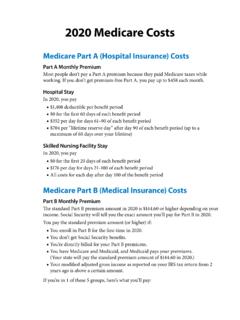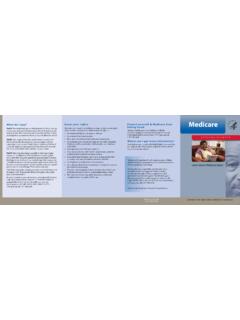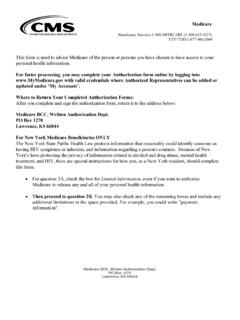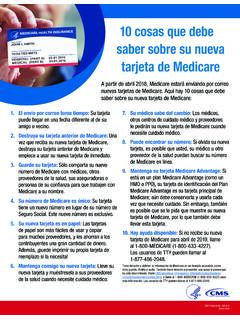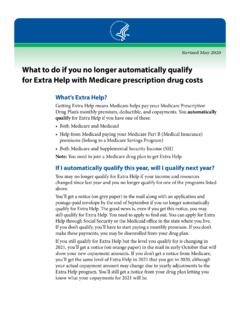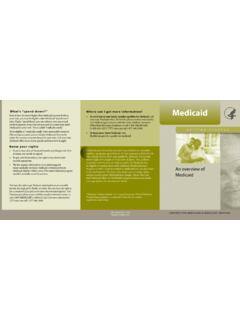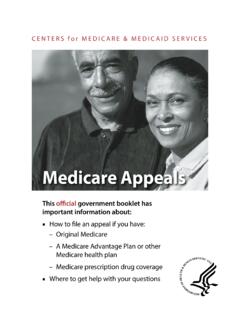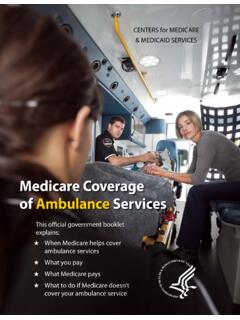Transcription of How Medicare Drug Plans Use Pharmacies, Formularies ...
1 Revised June 2019. How Medicare Drug Plans Use Pharmacies, Formularies , & Common Coverage Rules Each Medicare drug plan must give at least a standard level of coverage set by Medicare . Plans can vary on pharmacies they use, prescription drugs they cover, and how much they charge. Plans design their prescription drug coverage using different methods, like: Network pharmacies List of covered prescription drugs (formulary). Coverage rules In this fact sheet, the term Medicare drug Plans includes both Medicare Prescription Drug Plans and Medicare Advantage Plans with prescription drug coverage. Network pharmacies Medicare drug Plans have contracts with pharmacies that are part of the plan's network.
2 If you go to a pharmacy that isn't in your plan's network, your plan might not cover your drugs. Along with retail pharmacies, your plan's network might include preferred pharmacies, a mail-order program, or an option for retail pharmacies to supply a 2- or 3-month supply. Preferred pharmacies If your plan has preferred pharmacies, you may save money by using them. Your prescription drug costs (like a copayment or coinsurance) may be less at a preferred pharmacy because it has agreed with your plan to charge less. Mail-order programs Some Plans may offer a mail-order program that allows you to get up to a 3-month supply of your covered prescription drugs sent directly to your home.
3 This may be a cost-effective and convenient way to fill prescriptions you take regularly. 2- or 3-month retail pharmacy programs Some retail pharmacies may also offer a 2- or 3-month supply of covered prescription drugs. List of covered prescription drugs (formulary). Most Medicare drug Plans have their own list of covered drugs, called a formulary. Plans cover both generic and brand-name prescription drugs. The formulary includes at least 2 drugs in the most commonly prescribed categories and classes. This helps make sure that people with different medical conditions can get the prescription drugs they need. All Medicare drug Plans generally must cover at least 2. drugs per drug category, but Plans can choose which specific drugs they cover.
4 The formulary might not include your specific drug. However, in most cases, a similar drug should be available. If you or your prescriber (your doctor or other health care provider who's legally allowed to write prescriptions) believes none of the drugs on your plan's formulary will work for your condition, you can ask for an exception. See page 7 for more information on filing for an exception. A Medicare drug plan can make some changes to its drug list during the year if it follows guidelines set by Medicare . Your plan may change its drug list during the year because drug therapies change, new drugs are released, or new medical information becomes available. Plans may immediately remove drugs from their Formularies after the Food and Drug Administration (FDA) considers them unsafe or if their manufacturer removes them from the market.
5 Plans meeting certain requirements also can immediately remove brand name drugs from their Formularies and replace them with new generic drugs, or they can change the cost or coverage rules for brand name drugs when adding new generic drugs. If you're currently taking any of these drugs, you'll get information about the specific changes made afterwards. For other changes involving a drug you're currently taking that will affect you during the year, your plan must do one of these: Give you written notice at least 30 days before the date the change becomes effective. At the time you request a refill, provide written notice of the change and at least a month's supply under the same plan rules as before the change.
6 You may need to change the drug you use or pay more for it. You can also ask for an exception (see page 7). Generally, using drugs on your plan's formulary will save you money. If you use a drug that isn't on your plan's drug list, you'll have to pay full price instead of a copayment or coinsurance, unless you qualify for a formulary exception. All Medicare drug Plans have negotiated to get lower prices for the drugs on their drug lists, so using those drugs will generally save you money. Also, using generic drugs instead of brand-name drugs may save you money. 2. List of covered prescription drugs (formulary) (continued). Generic drugs The FDA says generic drugs are copies of brand-name drugs and are the same as those brand-name drugs in dosage form, safety, strength, route of administration, quality, performance characteristics, and intended use.
7 Generic drugs use the same active ingredients as brand-name prescription drugs. Generic drug makers must prove to the FDA that their product works the same way as the brand-name prescription drug. In some cases, there may not be a generic drug the same as the brand-name drug you take, but there may be another generic drug that will work as well for you. Talk to your doctor or other prescriber. Tiers To lower costs, many Plans place drugs into different tiers on their Formularies . Each plan can divide its tiers in different ways. Each tier costs a different amount. Generally, a drug in a lower tier will cost you less than a drug in a higher tier. Example of a drug plan's tiers Tier 1 lowest copayment: most generic prescription drugs Tier 2 medium copayment: preferred, brand-name prescription drugs Tier 3 higher copayment: non-preferred, brand-name prescription drugs Specialty tier highest copayment: very high cost prescription drugs In some cases, if your drug is in a higher (more expensive) tier and your prescriber thinks you need that drug instead of a similar drug on a lower tier, you can file an exception and ask your plan for a lower copayment.
8 See page 6. for more information on filing for an exception. Remember, this is only an example your plan's tiers may be different. 3. Coverage rules Plans may have coverage rules to make sure certain drugs are used correctly and only when medically necessary. These rules may include prior authorization, step therapy, and quantity limits as described below and on page 5. Prior authorization You may need drugs that require prior authorization. This means before the plan will cover a particular drug, you must show the plan you meet certain criteria for you to have that particular drug. Plans also do this to be sure these drugs are used correctly. Contact your plan about its prior authorization requirements, and talk with your prescriber.
9 Plans may also use prior authorization when they cover a medication for certain medical conditions, but not all medical conditions for which a drug is approved. When this occurs, Plans will have an alternative medication on their formulary (drug list) for the medical condition that isn't covered for a particular drug. However, if your prescriber believes it's medically necessary for you to be on that particular drug even though you don't meet the prior authorization criteria, you or your prescriber can contact the plan to request an exception. Your prescriber must give a statement supporting the request. If the request is approved, the plan will cover the particular drug, even if you didn't get prior authorization for the drug.
10 Step therapy Step therapy is a type of prior authorization. In most cases, you must first try a certain, less expensive drug on the plan's formulary that's been proven effective for most people with your condition before you can move up a step to a more expensive drug. For instance, some Plans may require you first try a generic drug (if available), then a less expensive brand-name drug on their drug list before you can get a similar, more expensive, brand-name drug covered. However, if your prescriber believes that because of your medical condition it's medically necessary for you to be on a more expensive step therapy drug without trying the less expensive drug first, you or your prescriber can contact the plan to request an exception.

